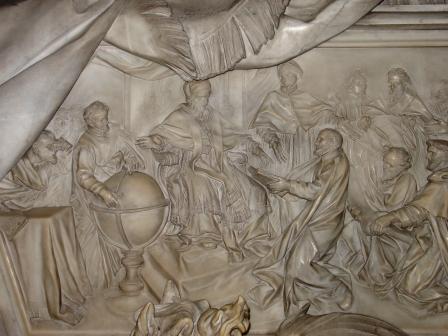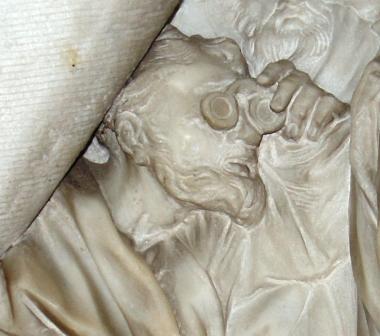 Today is the feast of St. Teresa of Avila.
Today is the feast of St. Teresa of Avila.
There is an interesting story about the Teresa and our present, modern Julio-Gregorian calendar.
In 1582, the ancient Julian calendar (organized by, yes, Julius Caesar and still observed by many Orthodox Christians) officially was terminated on Thursday 4 October by the command of Gregory XIII (1572–1585, Ugo Boncompagni) via the papal bull Inter gravissimas.
At midnight of 3-4 October the calendar skipped automatically to a day named Friday 15 October.
The famed Jesuit mathematician Christopher Clavius (+1612) worked out the calculations for this change. He chose October for the moment of the jump because it had the fewest feast days. He also did his calculations without the use of the decimal point!
St. Teresa of Avila died on the very night on which His Holiness had commanded that the calendar shift from 4 October to 15 October, which is why her feast is celebrated on the 15th rather than the 3rd or 4th.
If you are in Rome sometimes, stop my San Salvatore in Lauro and look at the chewed up little fountain to the left of the main doors of the church. It will probably be obscured by parked cars. On this llittle fountain is what’s left of a lamb. Over the fountain there is an inscription which inter alia speaks of a draco or “dragon” who, dutiful (pius), masters the whole globe or the world (draco qui toti pius imperat orbi). This is reference to Pope Gregory XIII whose coat of arms bore a dragon with wings outstretched. this is the Pope who ordered the change in the calendar and after whom we call our modern calendar Julio-Gregorian.
Here is the inscription on the fountain, for those of you who want to take a crack at it. You will need to know that virginea here refers to a famous Roman water source, called Acqua Vergine (which flows over the coins in the Fontana Trevi) and the lupus (“wolf”) and leo (“lion”) refer to other fountains, now lost, which were part of a set, this fountain being the “lamb”.
VT LVPVS IN MARTIS CAMPO MANSVETIOR AGNO
VIRGINEAS POPVLO FAVCE MINISTRAT AQVAS
SIC QVOQVE PERSPICVAM CVI VIRGO PRAESIDET VNDAM
MITIOR HIC HOEDO FVNDIT AB ORE LEO
NEC MIRVM DRACO QVI TOTI PIVS IMPERAT ORBI
EXEMPLO PLACIDOS REDDIT VTROQVE SVO
MDLXXVIIII
Going across the river to San Pietro in Vaticano, we search in the right side aisle for the tomb of Pope Gregory XIII and the interesting relief on his tomb.

It portrays the moment he was so proud of in his pontificate: when Clavius gave him the plans for the new calendar.

One of the things you must learn to do in Rome is pay attention to details, which are really rather funny at times. These people had a wonderful sense of humor.

What is interesting is the style of spectacles from that time, and that the sculptor included it. I haven’t gotten to the bottom of who this fellow might have been. The sculptor himself? The biographer of Gregory? Who knows?
By the way, one of my favorites Pope Sixtus V (1585-1590, Felice Peretti) said:
“Had the Jesuit order produced nothing more than this Clavius, on this account alone the order should be praised”. Clavius was an incredible mathematician who solved some of the most difficult problems of his day and who produced the essential textbooks of the era. Even the way we all learned Euclidian geometry when we were children is due mostly to the presentations of Clavius. His works were translated into Chinese by Matteo Ricci and others so that missionaries could connect with scholars in that far away land and thus bring them to the Gospel of Jesus Christ.
PS: Since it is also the Ides of October, today in ancient Rome would have been the day of the October Horse.


































Father Z, well done! Informative post and excellent use of the Ides.
March, July, October, May
The Nones are on the 7th day
The Ides are on the 15th day
Every year, I read something about tax day being “the Ides of April”, even though the Ides of April is April 13th.
As the wolf, gentler than a lamb, in the field of Mars, from its throat, ministers the virgin waters to the people, so also the lion, milder than a kid, pours from his mouth for them, the clear waves, presided over by the virgin. No wonder: the pious dragon who rules over the entire world, by his example, renders them placid.
Putting it into English is like playing Beethoven’s Fifth on a banjo.
St. Philip Neri who lived at this time is known to have a pair of eyeglasses like these.
“Putting it into English is like playing Beethoven’s Fifth on a banjo.” I laughed out loud. Thanks Andrew
You’re an absolute encyclopedia regarding Rome/Vatican City, and for that matter, anything to do with our Catholic faith. Thank you, Fr. Z.
I am always fascinated by this story!
Thanks, that is a really interesting story.
I remember hearing it long ago, but it is fascinating every time.
In a tangentially-related note (Father’s post mentioned Julius Caesar), Archaeologists believe they have found the first physical evidence of the spot where Caesar died. The full story can be read here: http://news.discovery.com/history/julius-ceasar-stabbing-121012.html
The Latin translation is over my head, but I noticed something interesting about the Roman numerals at the end: that ‘9’ is represented as VIIII, not VIX. Is the latter form a more modern innovation, or were both used interchangeably in the past?
Father Z, your knowledge is an inspiration for so many of us. Thank you for your Roman Chronicles, your reward will be in Heaven.
I do not know any Latin but manage to pray the Paternoster, Ave Maria and Credo of the Apostles in Latin just fine.
Ahh, St. Teresa de Jesus. She was the reason I clung to my faith as a teenager. I found her “Interior Castle” in my father’s library at the age of sixteen. She was my gateway drug to spiritual reading. First you’re reading Teresa and before you know it you’ve moved onto St. John of the Cross and all of the sudden you’re convinced that God and Heaven and Hell are real, and wondering what your vocation might be. All teenagers should be given things to read from the saints who knew and loved God in the most intimate way.
I enjoyed the Feast of this wonderfully wise Saint, a favourite of mine, but as she’s been declared a Doctor of the Church for more than forty years, why are we still celebrating her as V with a ‘Dilexisti’ Proper, instead of the greater honour of an ‘In Medio’ Mass for a Doctor?
(I spent some time after Mass apologizing to her.)
I’ve looked through the Proper and the Office, and I can’t see what would need altering. An ‘a’ for an ‘e’ at one or two points – little more, surely?
chantgirl – That’s a very good point, about properly guided reading from the Saints.
I found the ‘Way of Perfection’ to be a fantastic and practical guide, and an unexpectedly riveting page-turner.
Andrew, don’t give me any ideas…
Although Gregory XIII died when he was only 5, Spanish poet Francisco de Quevedo is the one who made those glasses famous. To this day, in Spain they are called “quevedos.”
http://3.bp.blogspot.com/-lXZfH0W_OMg/TfVVw5KIMEI/AAAAAAAAIYY/3oAwFQ9TPIk/s1600/quevedo2.jpg
Very interesting post… Thank you Father! I always found it interesting when the different countries, finally converted to the new Gregorian Calender too. It makes genealogy… er… interesting to say the least.